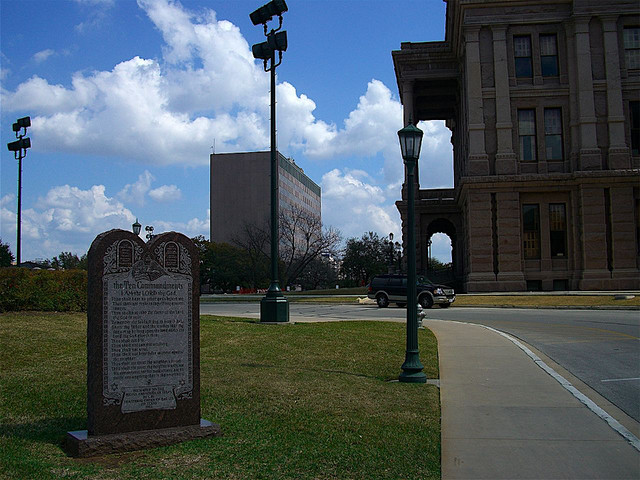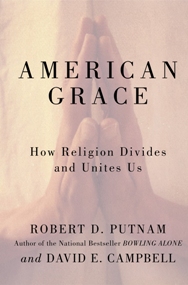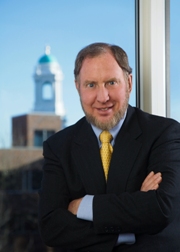
In American Grace: How Religion Divides and Unites Us, political scientist Robert Putnam drew from the two broadest surveys on religion in the U.S. to explore how the landscape of faith has transformed over the last 50 years. In the excerpt below, Putnam outlines how drastically our relationship to religion has changed since the days of “The Ten Commandments” and the John Kennedy candidacy.
 In the 1950s, the Fraternal Order of Eagles teamed up with movie director Cecil B. DeMille for a unique promotion of the epic movie The Ten Commandments. In a form of reverse product placement, the Eagles and DeMille donated monuments of the biblical Ten Commandments to communities all around the country.
In the 1950s, the Fraternal Order of Eagles teamed up with movie director Cecil B. DeMille for a unique promotion of the epic movie The Ten Commandments. In a form of reverse product placement, the Eagles and DeMille donated monuments of the biblical Ten Commandments to communities all around the country.
Rather than putting a product in the movie, the primary symbol of the movie was instead placed in prominent locations – in public parks, in front of courthouses, and in the case of Texas on the grounds of the state capitol. These monuments reflected the zeitgeist, as the 1950s brought public, even government-sanctioned, expression of religion to the fore in many ways. This was also the decade in which “In God We Trust” was added to American currency, and the Pledge of Allegiance was amended to include the words “under God.”
Those monuments stood for decades without causing a fuss. In recent years, however, they have led to court battles over whether their location on publicly owned land violates the constitutional prohibition on a government establishment of religion. In other words, fifty years ago these displays were so noncontroversial that they could safely be used as a marketing ploy for a big-budget Hollywood movie. Now they are the subject of litigation all the way to the Supreme Court.
Something has changed.
In 1960, presidential candidate John F. Kennedy had to reassure Protestants that they could safely vote for a Catholic. (At the time 30 percent of Americans freely told pollsters that they would not vote for a Catholic as president.) At the same time, Kennedy won overwhelming support from his fellow Catholics, even though he explicitly disagreed with his church on a number of public issues.
In 2004, America had another Catholic presidential candidate – also a Democratic senator from Massachusetts, also a highly decorated veteran, and also with the initials JFK. Like Kennedy, John (Forbes) Kerry also publicly disagreed with his church on at least one prominent issue – in this case, abortion. But unlike Kennedy, Kerry split the Catholic vote with his Republican opponent, and lost handily among Catholics who frequently attend church. Kennedy would likely have found it inexplicable that Kerry not only lost to a Protestant, but in George W. Bush, an evangelical Protestant at that. Writing about the religious tensions manifested in the 1960 campaign, political scientist Philip Converse described the election as a “flash of lightning which illuminated, but only momentarily, a darkened landscape.”
Kerry’s candidacy was another flash of lightning, but the landscape it revealed had changed significantly. In 1960, religion’s role in politics was mostly a matter of something akin to tribal loyalty – Catholics and Protestants each supported their own. In order to win, Kennedy had to shatter the stained glass ceiling that had kept Catholics out of national elective office in a Protestant-majority nation. By the 2000s, how religious a person is had become more important as a political dividing line than which denomination he or she belonged to. Church-attending evangelicals and Catholics (and other religious groups too) have found common political cause. Voters who are not religious have also found common cause with one another, but on the opposite end of the political spectrum.
Again, something has changed.
This book is about what has changed in American religion over the past half century. Perhaps the most noticeable shift is how Americans have become polarized along religious lines. Americans are increasingly concentrated at opposite ends of the religious spectrum – the highly religious at one pole, and the avowedly secular at the other. The moderate religious middle is shrinking. Contrast today’s religious landscape with America in the decades following the Second World War, when moderate – or mainline – religion was booming. In the past, there were religious tensions, but they were largely between religions (Catholic vs. Protestant most notably), rather than between the religious and irreligious. Today, America remains, on average, a highly religious nation, but that average obscures a growing secular swath of the population.
The nation’s religious polarization has not been an inexorable process of smoothly unfolding change. Rather, it has resulted from three seismic societal shocks, the first of which was the sexually libertine 1960s. This tumultuous period then produced a prudish aftershock of growth in conservative religion, especially evangelicalism, and an even more pronounced cultural presence for American evangelicals, most noticeably in the political arena. As theological and political conservatism began to converge, religiously inflected issues emerged on the national political agenda, and “religion” became increasingly associated with the Republican Party. The first aftershock was followed by an opposite reaction, a second aftershock, which is still reverberating. A growing number of Americans, especially young people, have come to disavow religion. For many, their aversion to religion is rooted in unease with the association between religion and conservative politics. If religion equals Republican, then they have decided that religion is not for them.
 Religious polarization has consequences beyond the religious realm, because being at one pole or the other correlates strongly with one’s worldview, especially attitudes relating to such intimate matters as sex and the family. Given that American politics often centers on sex and family issues, this religious polarization has been especially visible in partisan politics. A “coalition of the religious” tends to vote one way, while Americans who are not religious vote another.
Religious polarization has consequences beyond the religious realm, because being at one pole or the other correlates strongly with one’s worldview, especially attitudes relating to such intimate matters as sex and the family. Given that American politics often centers on sex and family issues, this religious polarization has been especially visible in partisan politics. A “coalition of the religious” tends to vote one way, while Americans who are not religious vote another.
The current state of religious polarization has led social commentators to use heated, even hyperbolic, language to describe the state of American society. The bestseller lists are full of books highly critical of religion, countered by pundits whose rhetoric decries a public square made “naked” by religion’s absence. In an overused metaphor, America is supposedly in the midst of a war over our culture.
And yet, when one ignores these venomous exchanges, and looks instead at how Americans of different religious backgrounds interact, the United States hardly seems like a house divided against itself. America peacefully combines a high degree of religious devotion with tremendous religious diversity – including growing ranks of the nonreligious. Americans have a high degree of tolerance for those of (most) other religions, including those without any religion in their lives.
Religion’s role in America thus poses a puzzle. How can religious pluralism coexist with religious polarization?
The answer lies in the fact that, in America, religion is highly fluid. The conditions producing that fluidity are a signal feature of the nation’s constitutional infrastructure. The very first words of the Bill of Rights guarantee that Congress – later interpreted to mean any level of government – will favor no particular religion, while ensuring that Americans can freely exercise their religious beliefs. In the legal arena, debates over such matters as whether the Ten Commandments can be displayed on public property hinge on the interpretation of the Constitution’s words. More broadly, the absence of a state-run religious monopoly combined with a wide sphere of religious liberty has produced an ideal environment for a thriving religious ecosystem. Religions compete, adapt, and evolve as individual Americans freely move from one congregation to another, and even from one religion to another. In the United States, it seems perfectly natural to refer to one’s religion as a “preference” instead of as a fixed characteristic.
This state of flux has actually contributed to religious polarization. A fluid religious environment enables people seeking something different to leave one religion for another, to find religion for the first time, or to leave religion altogether. This churn means that people gradually, but continually, sort themselves into like-minded clusters – their commonality defined not only by religion, but also by the social and political beliefs that go along with their religion.
From American Grace by Robert D. Putnam and David E. Campbell. Copyright © 2010. Reprinted by permission of Simon & Schuster, Inc, NY
*Photo of the Ten Commandments in Austin, Texas, courtesy Nathan Naze.




Send A Letter To the Editors